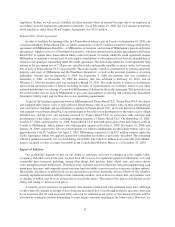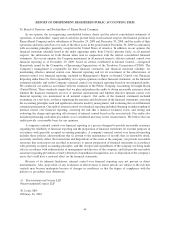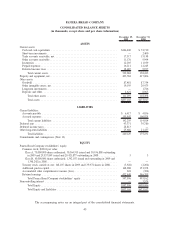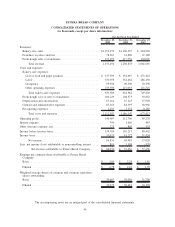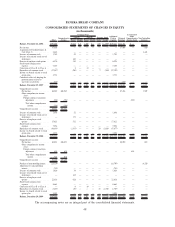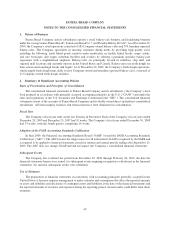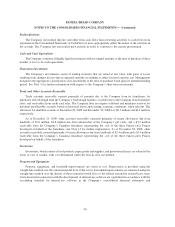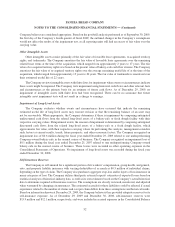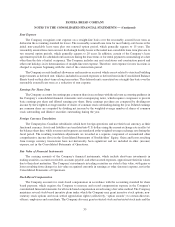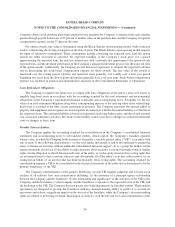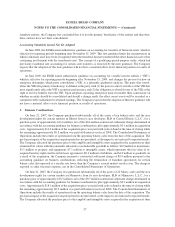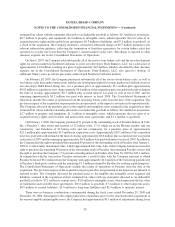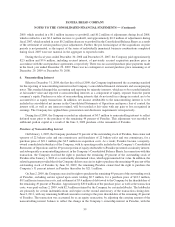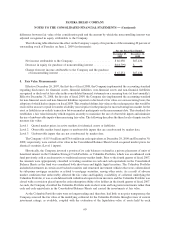Panera Bread 2009 Annual Report Download - page 57
Download and view the complete annual report
Please find page 57 of the 2009 Panera Bread annual report below. You can navigate through the pages in the report by either clicking on the pages listed below, or by using the keyword search tool below to find specific information within the annual report.accompanying notes, and amortized over the expected useful life of the asset. The estimated useful lives used for
financial statement purposes are:
Leasehold improvements ............................................... 15-20years
Machinery and equipment . . . ........................................... 3-10years
Furniture and fixtures ................................................. 2-7years
External signage ..................................................... 3-7years
Capitalizedsoftware.................................................. 3-5years
Interest, to the extent it is incurred, is capitalized when incurred in connection with the construction of new
locations or facilities. The capitalized interest is recorded as part of the asset to which it relates and is amortized over
the asset’s estimated useful life. No interest was incurred for such purposes for the fiscal years ended December 29,
2009 and December 25, 2007. Interest costs capitalized were approximately $0.1 million for fiscal year ended
December 30, 2008.
Upon retirement or sale, the cost of assets disposed and their related accumulated depreciation are removed
from the accounts. Any resulting gain or loss is credited or charged to operations. Maintenance and repairs are
charged to expense when incurred, while certain betterments are capitalized. The total amounts expensed for
maintenance and repairs were $30.7 million, $27.4 million, and $21.7 million for the fiscal years ended Decem-
ber 29, 2009, December 30, 2008, and December 25, 2007, respectively.
Goodwill
Goodwill consists of the excess of the purchase price over the fair value of net assets acquired. Goodwill and
indefinite-lived intangible assets recorded in the financial statements are required to be evaluated for impairment
annually or when events or circumstances occur indicating that goodwill might be impaired by the accounting
standard for goodwill and other intangibles. The Company performs its impairment assessment by comparing
discounted cash flows from reporting units with the carrying value of the underlying net assets inclusive of
goodwill. The Company completed annual impairment tests as of the first day of the fourth quarter of fiscal 2009,
fiscal 2008, and fiscal 2007, none of which identified any impairment. The fair value of the Company’s reporting
units exceeded carrying value by more than 100 percent for all the reporting units with goodwill.
As quoted market prices for the Company’s reporting units are not available, fair value is estimated based on
the present value of expected future cash flows, with forecasted average growth rates of approximately four percent
and average discount rates of 10 percent used in the fiscal 2009 analysis for the reporting units, which are
commensurate with the risks involved in the reporting units. The Company uses current results, trends, future
prospects, and other economic factors as the basis for expected future cash flows.
Assumptions in estimating future cash flows are subject to a high degree of judgment and complexity. The
Company makes every effort to forecast these future cash flows as accurately as possible with the information
available at the time the forecast is developed. However, changes in the assumptions and estimates may affect the
carrying value of goodwill, and could result in additional impairment charges in future periods. Factors that have the
potential to create variances between forecasted cash flows and actual results include but are not limited to
(i) fluctuations in sales volumes, (ii) commodity costs, such as wheat and fuel; and (iii) acceptance of the
Company’s pricing actions undertaken in response to rapidly changing commodity prices and other product costs.
Refer to “Forward-Looking Statements” included in the beginning of the Company’s Form 10-K for further
information regarding the impact of estimates of future cash flows.
The calculation of fair value could increase or decrease depending on changes in the inputs and assumptions
used, such as changes in the financial performance of the reporting units, future growth rate, and discount rate. In
order to evaluate the sensitivity of the fair value calculations on the goodwill impairment test, the Company applied
a hypothetical decrease in cash flows, and made changes to its projected growth rate and discount rate which the
51
PANERA BREAD COMPANY
NOTES TO THE CONSOLIDATED FINANCIAL STATEMENTS — (Continued)


